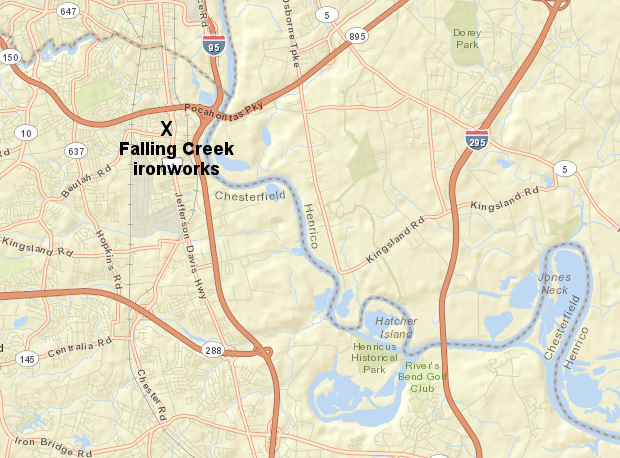
the initial development of an iron furnace at Falling Creek was destroyed in 1622
Source: ESRI, ArcGIS Online

the initial development of an iron furnace at Falling Creek was destroyed in 1622
Source: ESRI, ArcGIS Online
Virginia's first steps into the Industrial Revolution started with the iron industry. Virginia's very first iron furnace was located on Falling Creek, upstream from Henricus on the James River (near where the modern Pocahontas Bridge crosses the James River).
That operation was destroyed in the 1622 uprising. The colony depended almost exclusively upon European imports of iron pots, farm tools, kitchen knives, nails, hinges, etc. for another century, until Governor Spotswood ignored instructions from England to limit competition and proceeded to start the iron industry in Virginia.
Governor Spotswood discovered an iron deposit upstream of the Fall Line on the Rappahannock River in 1713. He then used his authority to encourage settlement in the Rappahannock River watershed rather than the James River watershed. While his efforts to establish a defensive frontier west of the Fall Line could be justified as legitimate government activity, he also ensured new roads were built where he could personally benefit. What today would be considered a "conflict of interest" was just common practice in colonial Virginia.
Spotswood imported indentured servants from what today is Germany and opened up the Tubal Furnace before he was replaced as governor in 1722.
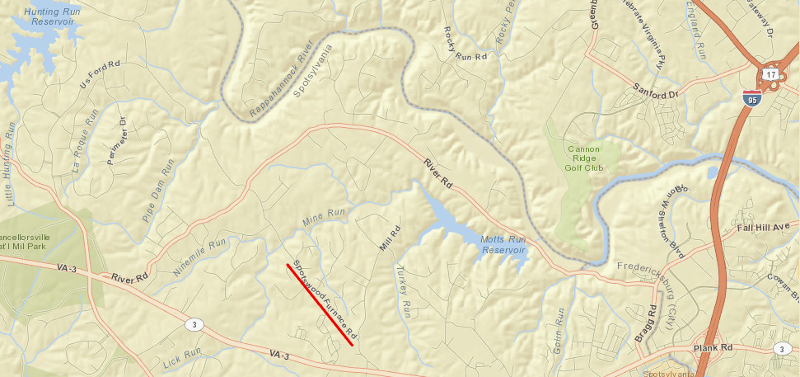
Tubal Furnace is recorded today by a road name in Spotsylvania County
Source: ESRI, ArcGIS Online
The initial settlement of the servants on the Rapidan River is known today as Germanna. Those workers left after completing their terms of service, moving to the Fauquier County community known ever since as Germantown. Spotswood then bought slaves to operate the ironworks, and half of the workers made charcoal to fuel the operation. Within 20 years after Tubal Furnace opened, there were only two non-slave workers out of the 160 employed there.1
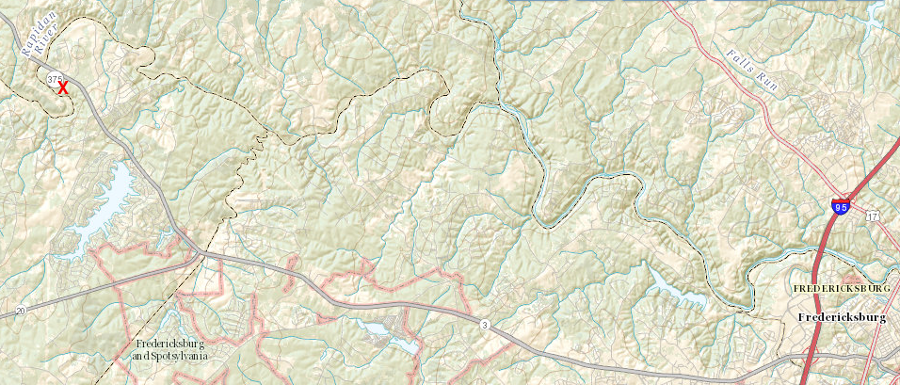
Germanna (red X) is west of Fredericksburg, upstream on the Rapidan River
Source: US Geological Survey (USGS), The National Map - Hydrography
Spotswood may have started the first successful iron production operation in colonial Virginia, but others soon followed. The Tayloe family opened up the Neabsco Iron Works in Prince William County in the 1730's, and George Washington's father Augustine managed the Accokeek Furnace in Stafford County.
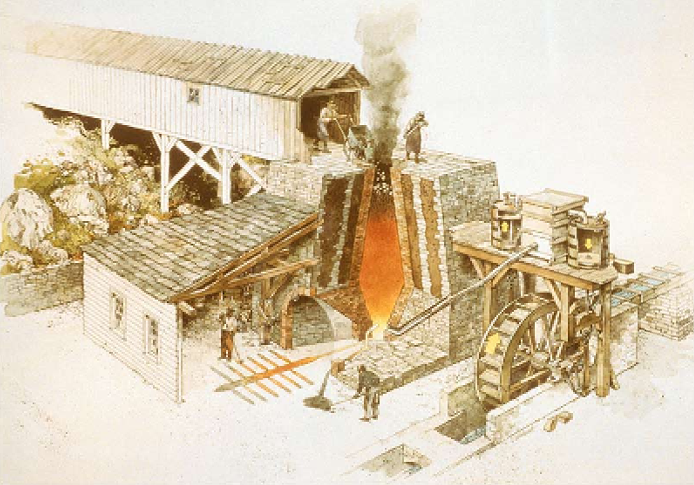
starting around 1737, forests were converted into charcoal to fuel the furnace at the Neabsco Iron Works
Source: National Park Service, 19th-century blast furnace in operation
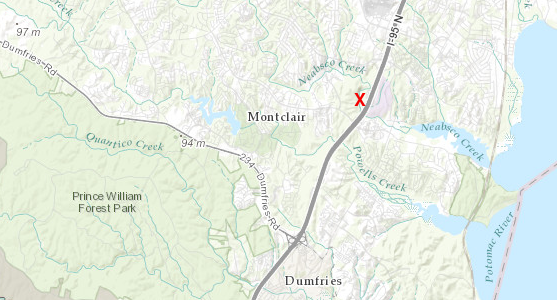
Neabsco Iron Works was located in eastern Prince William County, close to the waterfront
Source: ESRI, ArcGIS Online
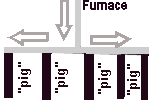 The iron supplies in Virginia were limited, but there were extensive forests. To fuel an iron furnace, great mounds of firewood was stacked and covered with a thick coating of clay. The firewood was set on fire, and a "collier" opened and closed holes in the clay to control the amount of air that could reach the fire. Too much air and the firewood ended up as useless ash, but if managed well it could be converted into charcoal. This fuel was added to iron ore and seashells (or limestone) in tall furnaces. Furnaces located near waterfalls used bellows to blow air into the base to heat the mixture, until the iron melted and settled at the bottom of the furnace.
The iron supplies in Virginia were limited, but there were extensive forests. To fuel an iron furnace, great mounds of firewood was stacked and covered with a thick coating of clay. The firewood was set on fire, and a "collier" opened and closed holes in the clay to control the amount of air that could reach the fire. Too much air and the firewood ended up as useless ash, but if managed well it could be converted into charcoal. This fuel was added to iron ore and seashells (or limestone) in tall furnaces. Furnaces located near waterfalls used bellows to blow air into the base to heat the mixture, until the iron melted and settled at the bottom of the furnace.
Once or twice during the day (or night - furnaces were fueled 24 hours a day when in "blow"), the ironmaster would crack open a clay seal at the bottom of the furnace. If he was skilled in evaluating the color of the smoke, or had a professional sense of timing, then molten iron would flow out of the furnace into a series of trenches and shallow pits dug into sand. The furnace workers were familiar with farm life and the rows of iron ingots connected to one another looked like nursing piglets, so Virginia's first major Industrial Revolution product was "pig iron."
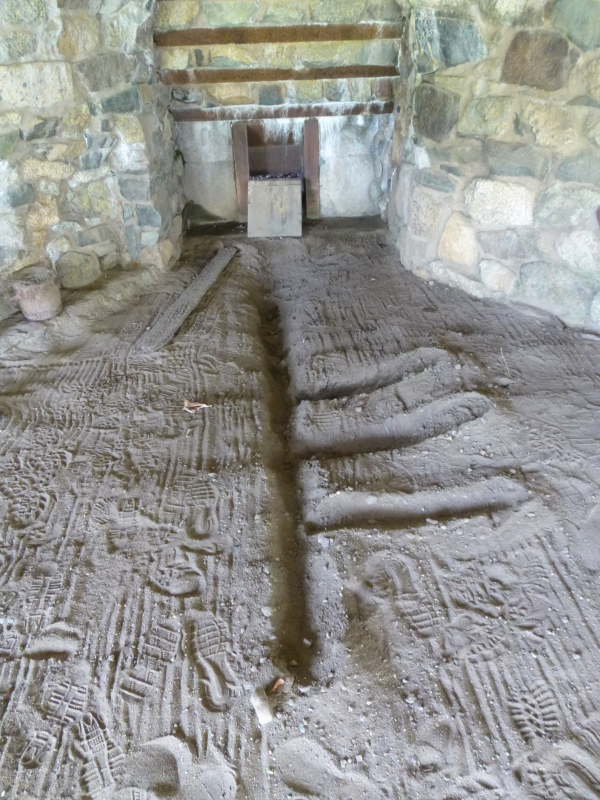
troughs in sand (normally dug out on both sides) were filled with molten iron, and after cooling the "piglets" were broken free from the "sow" in the middle
The recipe for making iron at the Newlee Iron Furnace at Cumberland Gap was described by the National Park Service:2
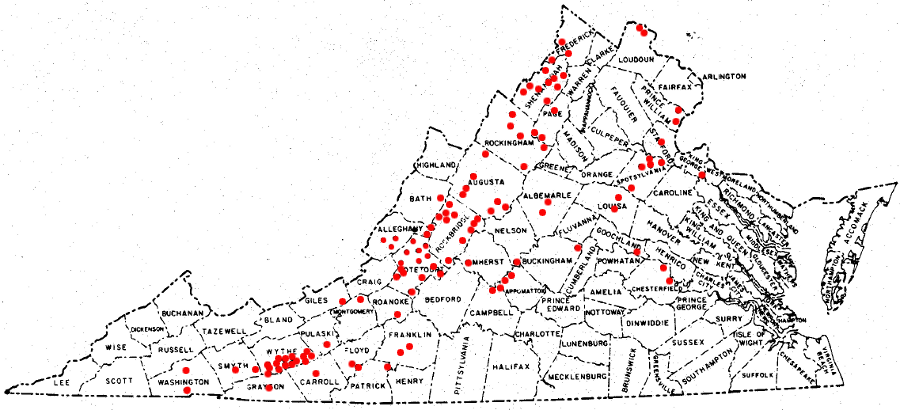
iron furnaces in Virginia were concentrated west of the Blue Ridge
Source: Virginia Department of Mines, Minerals and Energy (DMME), the Charcoal Iron Industry in Virginia
Until the Civil War, Virginia's known iron ore deposits were similar in quality as the ore deposits in Pennsylvania and elsewhere. Virginia had a competitive advantage with low-cost slave labor, as well as extensive forests.
Furnaces in the Shenandoah Valley could supply local demand west of the Blue Ridge and even export ingots via wagon to Alexandria, Baltimore, and Philadelphia, and floated down the Shenandoah River from as far upstream as Port Deposit. Furnaces near the James River were able to take advantage of low-cost transportation via the James River and Kanawha canal.
However, Virginia's furnaces stayed as low-tech operations. Virginia's capitalists focused on their existing investments in their slaves, rather than purchase new equipment that minimized labor costs. Meanwhile, competitors implemented new processes to increase their productivity and the quality of their product - and unlike Virginia, Northern manufacturers were able to take advantage of lower-cost transportation resulting from successful construction of canals and railroads. As a result, Virginia railroads built their systems with iron rails imported from England or Northern manufacturing facilities.
After the Civil War, when northern capitalists gained control over Virginia's economy and rationalized the pattern of railroads, the Norfolk and Western Railroad was finally built through the Shenandoah Valley and the iron furnaces there gained access to cheap transportation. The railroad was built through the Page Valley east of Massanutten Mountain in order to obtain the business of the Big Gem Furnace, Catherine Furnace, and other iron producers on the western flank of the Blue Ridge.
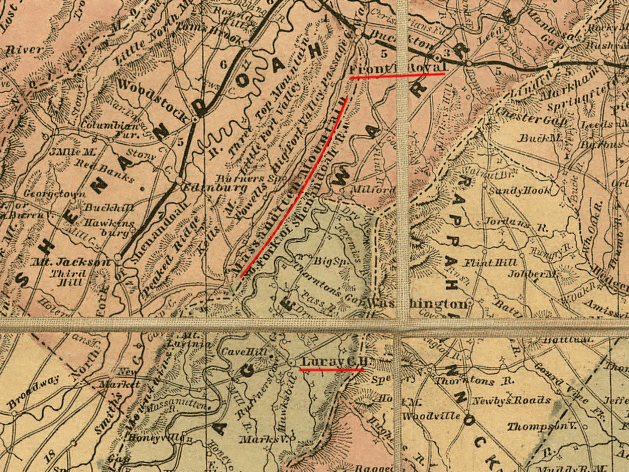
before the Civil War, the Manassas Gap railroad (heavy black line) had already been built to Mount Jackson - but after the war, the Norfolk and Western railroad was built on the east side of Massanutten Mountain (south from Front Royal, through Luray and the Page Valley) to connect with the iron furnaces
Source: Library of Congress, Lloyd's official map of the state of Virginia from actual surveys by order of the Executive 1828 & 1859
In the 1880's, population centers such as Harrisonburg and Staunton were located along the original Great Valley Road west of Massanutten Mountain (now Route 11/I-81). However, the Norfolk and Western Railroad calculated it could bypass population centers and make a greater profit from shipping iron. Today, the Norfolk and Southern Railroad is still moving trains east of Massanutten Mountain. On the west side of the mountain (along I-81), traffic is no longer sufficient to keep trains operating; there is no rail service now between Edinburg and Mount Jackson.
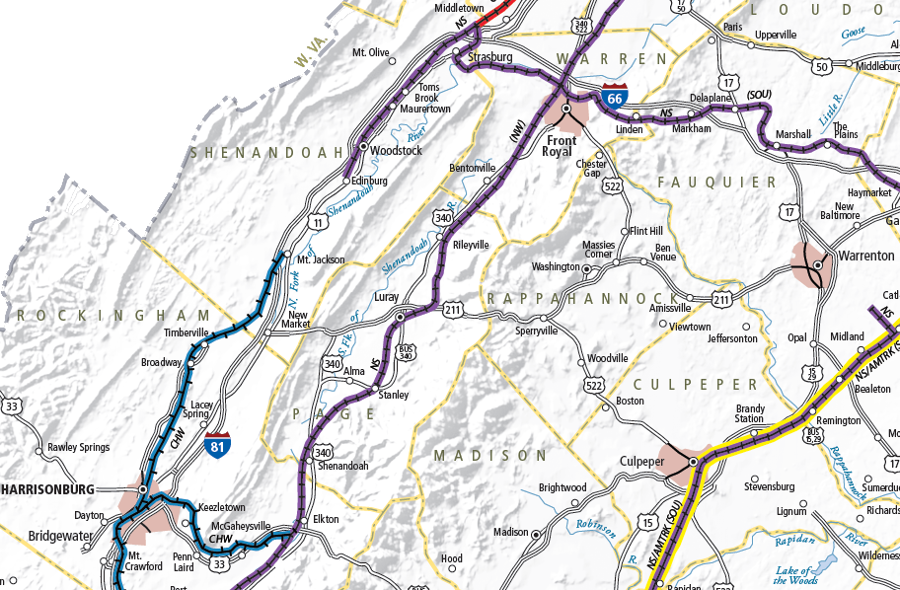
the Norfolk and Western line built east of Massanutten Mountain in 1881 is still operating, while the older rail connection on the west side is now fragmented (with no rail service between Edinburg-Mount Jackson)
Source: Department of Rail and Public Transportation, State Rail Map
The Tredegar Iron Works in Richmond was Virginia's largest iron manufacturing facility, processing Virginia-made pig iron floated down the James River or imported from northern states. The operation started in 1837, and relied upon waterpower from the James River and Kanawha Canal to provide the energy to cut and bend metal. The operation manufactured a wide range of industrial and consumer products, including locomotives.
Tredegar Iron Works made the iron plates for the CSS Virginia in Civil War, as well as cannon. The facilities were not destroyed in the Richmond fire in 1865, but operations faded after the Civil War when northern manufacturers shifted to steel production and finally ended in 1952. Today, the remaining buildings at the once-busy industrial site are historical visitor centers and museums that interpret the Civil War.
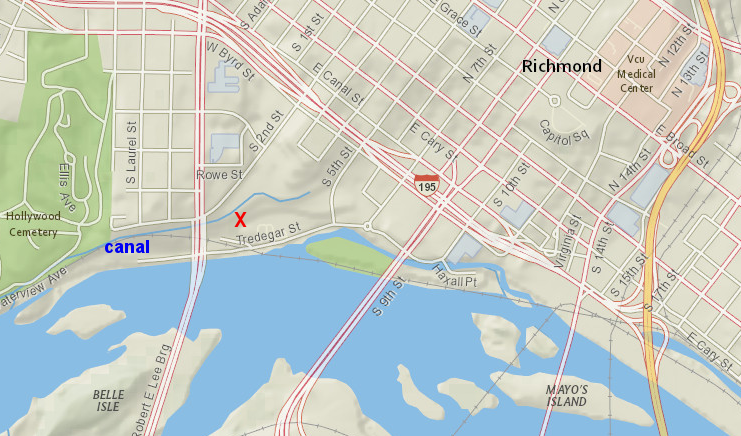
Tredegar Iron Works used waterpower provided from the James River and Kanawha Canal
Source: ESRI, ArcGIS Online
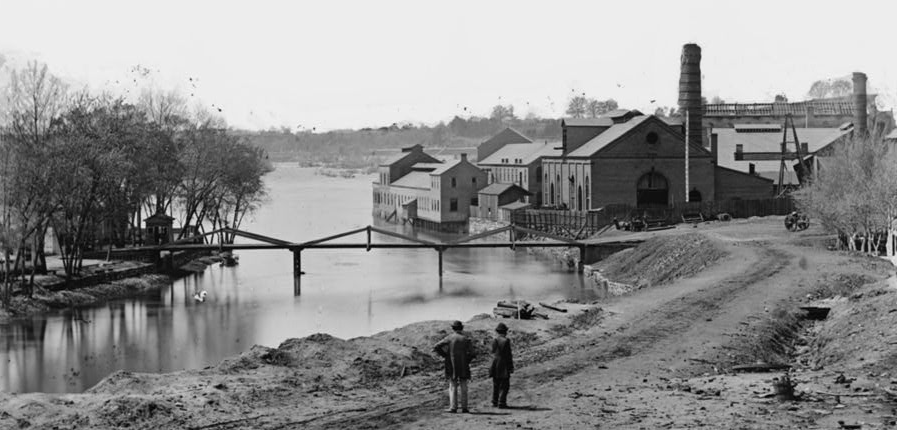
Tredegar Iron Works survived the fire that burned much of downtown Richmond at the end of the Civil War, but not the later competition from more-efficient operations
Source: Library of Congress, View of the Tredegar Iron Works